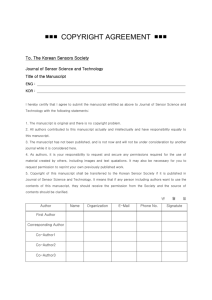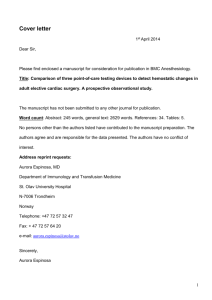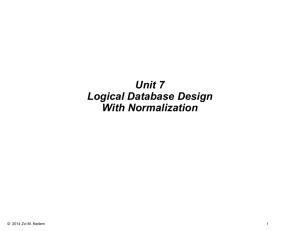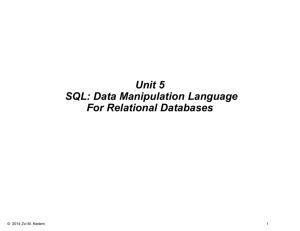Bio-beads with Immobilized Anaerobic Bacteria, Zero
advertisement
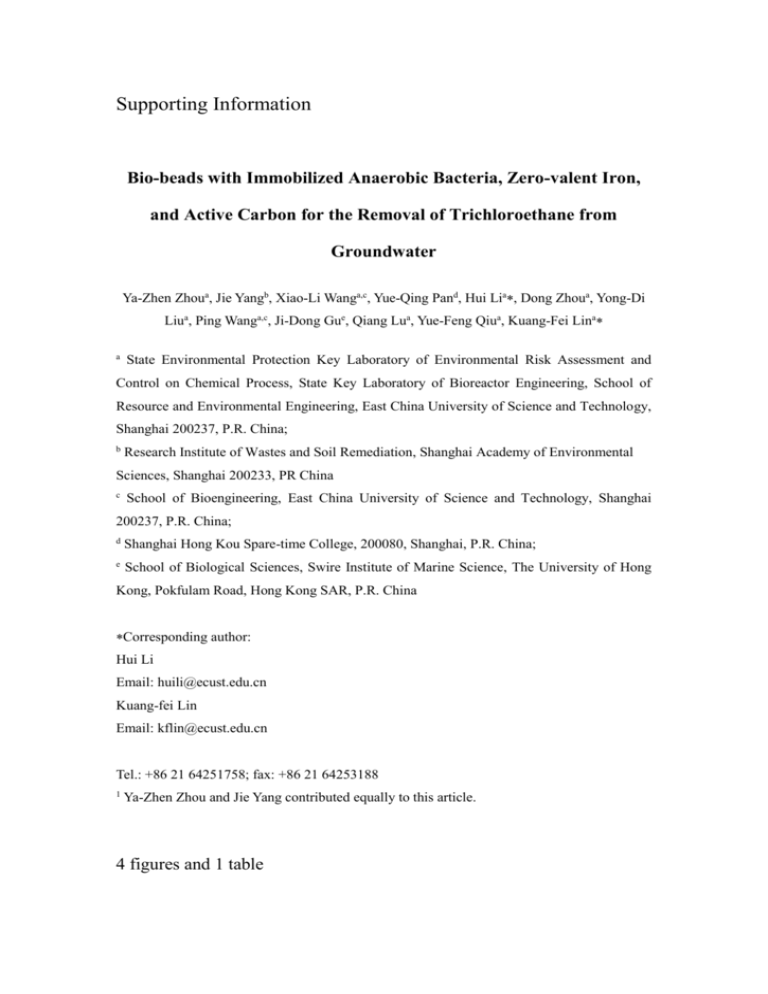
Supporting Information Bio-beads with Immobilized Anaerobic Bacteria, Zero-valent Iron, and Active Carbon for the Removal of Trichloroethane from Groundwater Ya-Zhen Zhoua, Jie Yangb, Xiao-Li Wanga,c, Yue-Qing Pand, Hui Lia, Dong Zhoua, Yong-Di Liua, Ping Wanga,c, Ji-Dong Gue, Qiang Lua, Yue-Feng Qiua, Kuang-Fei Lina a State Environmental Protection Key Laboratory of Environmental Risk Assessment and Control on Chemical Process, State Key Laboratory of Bioreactor Engineering, School of Resource and Environmental Engineering, East China University of Science and Technology, Shanghai 200237, P.R. China; b Research Institute of Wastes and Soil Remediation, Shanghai Academy of Environmental Sciences, Shanghai 200233, PR China c School of Bioengineering, East China University of Science and Technology, Shanghai 200237, P.R. China; d Shanghai Hong Kou Spare-time College, 200080, Shanghai, P.R. China; e School of Biological Sciences, Swire Institute of Marine Science, The University of Hong Kong, Pokfulam Road, Hong Kong SAR, P.R. China Corresponding author: Hui Li Email: huili@ecust.edu.cn Kuang-fei Lin Email: kflin@ecust.edu.cn Tel.: +86 21 64251758; fax: +86 21 64253188 1 Ya-Zhen Zhou and Jie Yang contributed equally to this article. 4 figures and 1 table Fig. S1 Images of the bio-beads (a); SEM images of the cross-scion of bio-beads before (b)and after(c) treatment of TCA. 80 a b c 70 Concentration(mg/L) 60 control 1,1,1-TCA 1,1-DCA 50 40 30 20 10 0 0 2 4 6 8 10 12 14 16 18 Time(d) Fig. S2 The disappearance of 1,1,1-TCA and appearance of 1,1-DCA by bio-beads with 1.0% activated carbon 2500 a Dencity(CPS) A-C B-Fe B 2000 A 1500 1000 B 500 0 10 30 20 70 60 50 40 80 2Theta(deg.) 1400 b A-C B-Fe C-FeS D-FeCO3 C Dencity(CPS) 1200 1000 800 A 600 C C D C B 400 D B 200 0 10 20 30 40 50 60 70 80 2Theta(deg.) Fig. S3 of TCA. XRD pattern of the precipitates formed in the bio-beads before(a) and after(b) treatment S4: The bio-beads (anaerobic bacteria + ZVI + AC) were filled into a polytetrafluoroethylene tube which has small holes on the tube walls. The small holes on the tube walls can let contaminants in groundwater make full contact with the bio-beads. Then the tube with bio-beads was installed in treatment well distributed on the downstream region of a contaminant plume. A network of treatment wells was installed in the core of the plume where natural artesian groundwater conditions are used to support the capture of impacted groundwater for transport to the customized treatment tube (Fig. S4). Similar to the permeable reactive barrier (PRB), this in situ technology could be used to intercept and degradate groundwater contaminants, but the difference is the bio-beads could be reused seven times and replaced easily by the new one. So the further evaluation of the bio-beads in real field is just beginning in TCA contaminated sites in the Pudong district of Shanghai. Fig. S4 Schematic diagram for the use of bio-beads in-suit Table S1 Tests of between-subjects effects Source df Mean Square F Sig. A B A*B Error 2 2 4 18 0.010 0.008 0.000 0.000 81.932 64.264 3.645 0.000 0.000 0.024 df= degree of freedom The following is a point-to-point response to the reviewers’ comments. Reviewer #1: Specific Comments [1] What is the mechanism of TCA removal by anaerobic bacteria, zero-valent iron (ZVI) and activated carbon powder? Need to explain using more updated references. Response : Thank for your advice on the mechanism of TCA removal by bio-beads. The paragraph has been added in the last paragraphthe of 3.7 in revision manuscript. (page 12, line 5 to page 13, line 3) [2] How does this technique work in real field system? Response : We have added this part in the supporting information S4. [3] What was the degradation rate of TCA compared to literature? Response : We have cited 2 recent references here to compare the TCA degradation rate. (page 11, line 34 to page 12, line 4) Reviewer #2: General Comments Authors insisted that very limited literatures are available on the topic. However, numerous articles have been published on remediation of chlorinated hydrocarbons by ZVI, AC and/or anaerobic bacteria during the last two decades. Authors need to explain and emphasize the novelty of this work in the introduction with comprehensive literature review on the topic. Hypothesis and objectives of the study need to be better presented. Response : We would like to express our gratitude for your advice to improve our manuscript quality. We have re-written the introduction, and have cited some recent references to compare with. We also introduced the future applications of biobeads. (line 14 – 27, page 4) As the immobilization method is very well established, authors need to explain advantages of combining the three different materials (anaerobic bacteria + ZVI + AC) by immobilization for the removal of trichloroethane in groundwater with information for economic evaluation if available. Response : We would like to express our gratitude for your advice. The possibility of corrosion may exist as a potential limitation factor for the sustainability of using Fe0 for in situ remediation. So we combined ZVI and anaerobic microorganisms to enhance its reusability. (line 8 – 10, page 4) There were many spelling/typographical and grammatical errors in the current manuscript. The overall English needs to be significantly improved before its re-submission. There are also several additional concerns on the manuscript that need to be well addressed when submitting revised version. Response : We express our apology for these mistakes due to our poorly English presentation. We have checked all this paper times, and all the errors and omissions checked out have been corrected. Specific Comments [1] Authors provided five persons as first/corresponding authors of the manuscript. By considering author guideline and scale of the work, it looks quite unusual. Please discuss the issue with responsible editor and EIC. Response : We have discussed and modified the authors of the manuscript. [2, 8, 9] Authors provided total eleven tables and figures for this study. Please reduce the numbers of tables and figures. Some of them can be moved to supplementary file. Response : We agreed with the reviewer’s comments. We have removed three figures and one table to supplementary file as suggested. [3] Please modify current title and re-write the abstract. Please use proper tense in the abstract. Response : We express our apology for these mistakes due to our poorly English presentation. We have re-write the abstract, and all the errors and omissions checked out have been corrected. [4] Please provide reference for Section 2.3. Response : We have cited references about the anaerobic medium. (line 18, page 5) [5] Conclusion part is repeating of abstracts and discussion parts. Please add implication of this work and add more in depth conclusions. Response : We have re-written the conclusions with the implication of this work. (line 6-18, page 13) [6] There are several errors in the references. Please fully revise the manuscript according to author guideline. Response : We express our apology for these mistakes. We have checked all this paper times, and all the errors and omissions checked out have been corrected. [7] Please provide scale for Figures 1 (a). Response : We express our apology for this mistake. We have provided scale for Figures S1 (a).






